Employee Burnout in the United States: Key Symptoms, Business Impact, and Prevention Strategies
Last Updated Nov 13, 2025

Key Takeaways
- Burnout is a long-lasting state of exhaustion that comes from steady workplace pressure. This strain reduces mental, physical, and emotional capacity and makes it harder for workers to stay motivated, focused, and engaged.
- The effects of burnout spread across a business and harm financial and operational outcomes. Productivity declines, turnover rises, absences increase, healthcare costs grow, and hiring becomes harder, which leads to a clear impact on performance.
- Workplace conditions shape burnout risk for people in all roles and industries. Heavy workloads, limited support, unfair treatment, harmful behaviors, and value mismatches create ongoing pressure that builds over time.
- System-level changes offer the strongest path to lowering burnout in a lasting way. Realistic workloads, supportive cultures, equipped managers, meaningful goals, and clear growth options give employees the foundation they need to regain energy and succeed.
- HR teams help identify burnout early and guide healthier work practices. Approaches that combine organizational improvements with accessible recovery resources give employees the stability and structure needed for long-term wellbeing.
Burnout isn’t an individual problem—it’s a business threat.
Nearly half of U.S. workers say job stress is damaging their mental health, making burnout a top driver of disengagement, turnover, and lost productivity. This makes it clear that burnout doesn’t start with employees. It starts with the workplace itself. Long hours, poor management, and overwhelming workloads aren’t just stressing employees out—they’re pushing them toward exhaustion and disengagement.
And the costs? Missed deadlines, rising healthcare claims, and steep hiring bills as talented people walk away.
So, what can you do about it? Proactive prevention. By understanding burnout’s true causes and symptoms, HR leaders like you can design strategies that protect your workforce and strengthen your business from the inside out.
Discover how to prevent burnout before it takes hold. Here’s how to help your employees recharge, re-engage, and thrive.
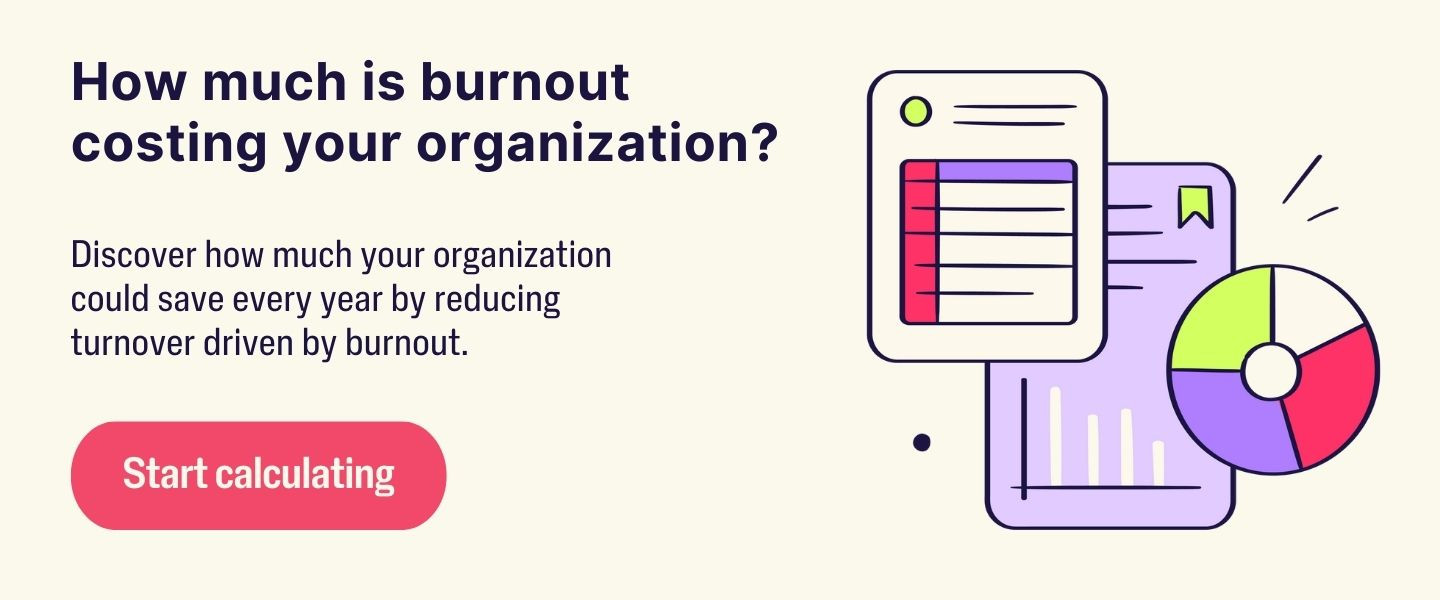
What Is Employee Burnout?
Employee burnout is a state of mental, physical, and emotional exhaustion triggered by chronic workplace stress. It often manifests as feelings of hopelessness, fatigue, irritability, cynicism, difficulty concentrating, and reduced productivity. In more severe cases, it can escalate into depression or other significant mental and physical health issues.
It’s critical to note that the World Health Organization (WHO) classifies burnout as an “occupational phenomenon” rather than a medical condition. This means burnout stems specifically from unmanaged workplace stress, not personal life pressures. Burnout always starts at work.
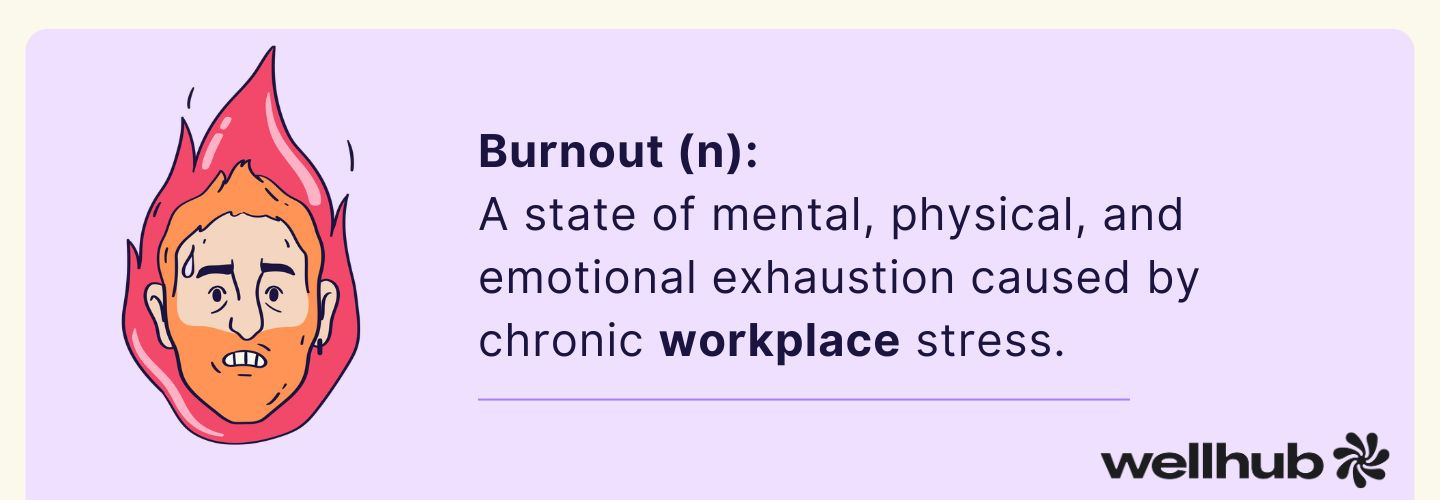
Burnout vs. Workplace Stress: What’s the Difference?
While workplace stress and burnout are closely related, they’re not the same thing. Stress often brings feelings of anxiety and irritability. Burnout, on the other hand, tends to foster detachment, cynicism, and even apathy. Employees may feel emotionally drained, disconnected from their work, and struggle to find personal fulfillment.
Here’s how to tell them apart, according to the British Association for Counseling and Psychotherapy:
- Duration: Stress typically subsides once the triggering issue is resolved. Burnout, however, can linger long after the initial stressor is gone—its effects are more enduring.
- Emotional Impact: Stress may cause short-term irritability or nervousness. Burnout goes deeper, often bringing chronic demotivation, frustration, and emotional numbness.
- Physical Symptoms: Stress might cause headaches, muscle tension, or digestive issues. Burnout, however, can lead to chronic fatigue, a weakened immune system, and more serious health risks like cardiovascular problems.
Recognizing these distinctions matters: addressing burnout requires more than just resolving immediate stressors. This problem demands organizational change and long-term wellbeing strategies.
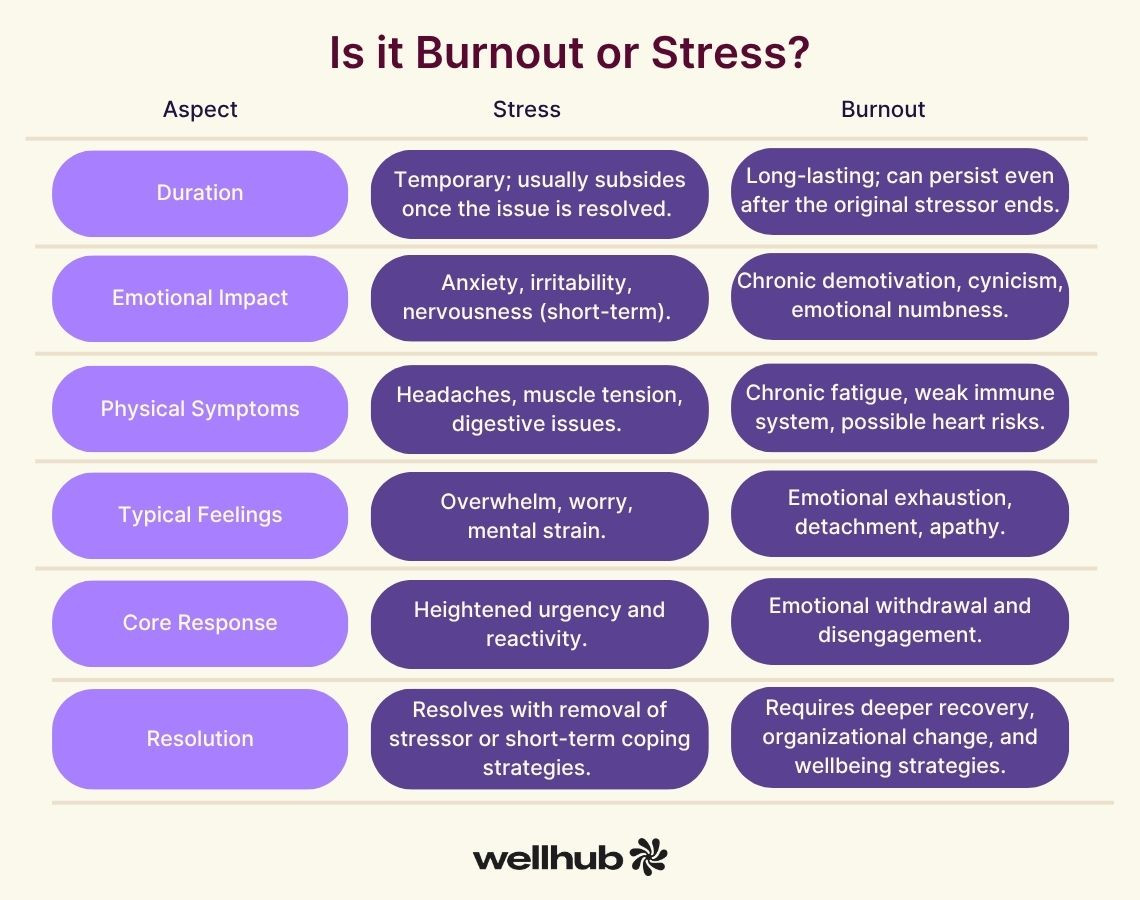
Spot burnout—22 signs to look for before it’s too late.
The Business Cost of Employee Burnout in the United States
Employee burnout is draining your bottom line. As stress builds, productivity declines, errors increase, and innovation stalls.
What does this mean for your bottom line? Increased absenteeism is a start. Employees experiencing burnout are more likely to call in sick. Or, if they show up, they get little to nothing done. When this happens over a prolonged period of time, you’ve got quiet quitting on your hands.
That kind of presenteeism decreases your company’s ability to innovate. Burnt-out employees aren’t bringing their best ideas to the table because they’re focused on survival: Burnt-out workers experience mental rigidity, lower cognitive flexibility, and impaired working memory. All of these factors are critical for creative problem-solving and idea generation, and their depletion makes thinking outside the box much more difficult.
Then there’s full-on quitting. Burned‑out employees are six times more likely to say they plan on quitting their job within the next six months. Turnover costs that can reach up to 2 times each lost employee’s salary; multiply that across departments, and the financial burden adds up fast.
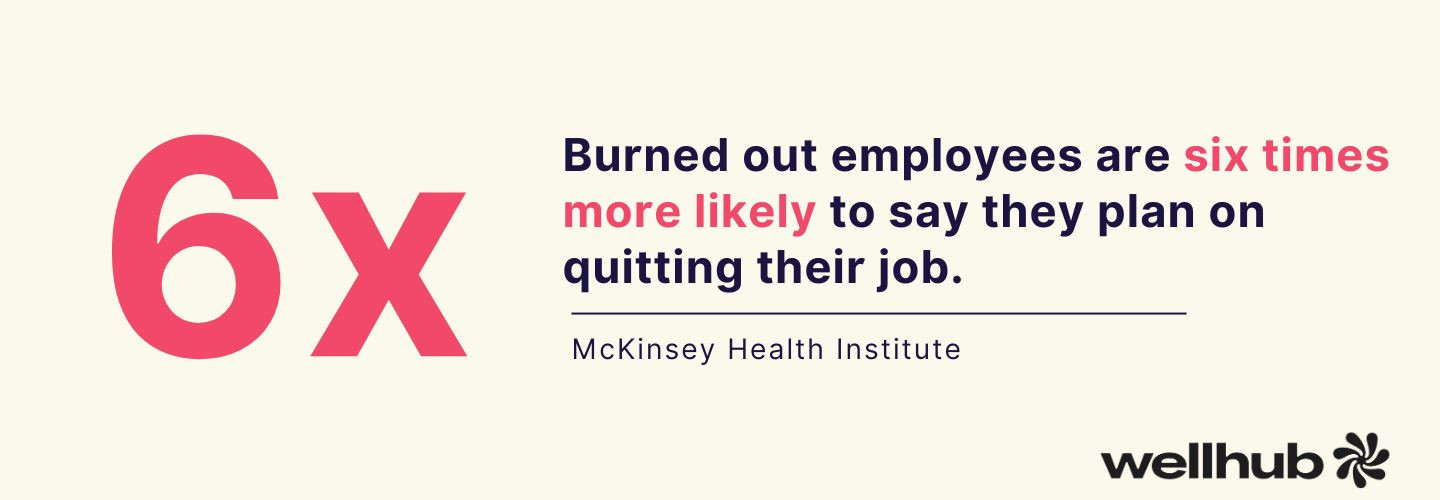
Burnout also impacts healthcare costs. Healthcare costs attributed to workplace burnout range from $125 billion to $190 billion annually. These costs are primarily driven by increased claims for chronic and stress-related illnesses, which include mental health disorders, heart disease, and musculoskeletal complaints that are well documented as common outcomes of long-term stress.
Then there’s brand reputation: a culture of burnout can make your organization less attractive to top talent. Nearly nine out of 10 of employees will only consider companies that place a clear emphasis on employee wellbeing during their next job search. If your Glassdoor profile is full of burnt out employee reviews, recruiting high-quality hires is going to take longer and be more expensive.
In short, burnout bleeds revenue from every corner of your business. Preventing it more than a feel-good HR initiative—it’s a strategic imperative. Building a culture that actively supports wellbeing is one of the smartest financial decisions you can make.
How Burnout Impacts Your Organization
Even if just one employee burns out, your entire organization feels it. But burnout is rarely isolated. It spreads, shifting workloads, slowing deadlines, and draining morale.
Let’s break down the impact:
- Declining Productivity
Burned-out employees may show up physically, but mentally, they’ve checked out. Chronic exhaustion clouds focus, weakens memory, and slows decision-making. The result? More errors, slower work, and underperformance. This is part of why presenteeism (being physically present but mentally absent) costs the American economy 1.5 trillion every year.
- Increased Absenteeism
Struggling employees are more likely to call out sick, making burnout a key driver of unscheduled absences and mounting costs. In fact, a full 10% of burnout costs come from absenteeism.
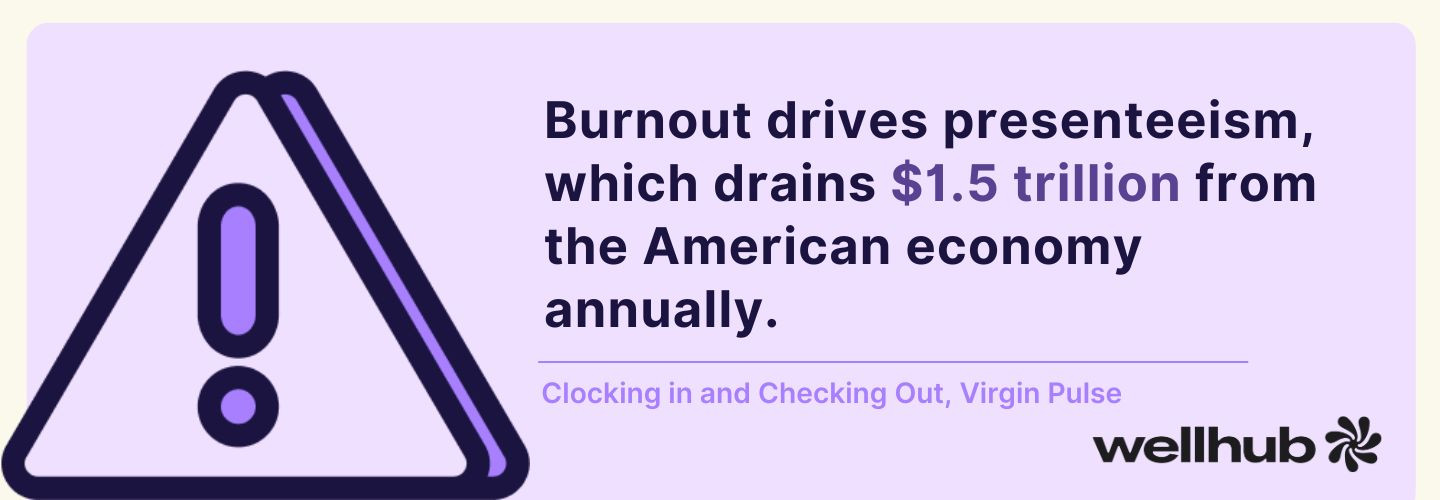
- Higher Turnover Rates
Burnout pushes people to leave, eroding community and draining budgets. Because replacing talent isn’t cheap—the Society for Human Resource Management (SHRM) estimates replacing an employee costs between 50% to 200% of their annual salary.
- Lower Morale and Engagement
Employee engagement in the U.S. is bottoming out: just 30% felt engaged in early 2024, the lowest level in a decade. As burnout disconnects employees from their work and their teams, collaboration stalls and communication breaks down. This isolation breeds disengagement, bad news for culture and productivity alike.
- Health Risks and Rising Medical Costs
Burnout degrades emotional and physical health. Employees experiencing burnout are more likely to be admitted to the hospital for mental health and cardiovascular distress. In addition to leaving employees unable to work, this drives up healthcare costs. (No wonder the majority of CEOs and HR leaders say wellness programs decrease healthcare costs.)
What Causes Employee Burnout?
Burnout doesn’t have a single cause. It’s the result of sustained workplace challenges that vary across employee demographics. As revealed in Wellhub’s State of Work-Life Wellness 2025 report, generational differences often shape what drives burnout:
- Younger employees (Millennial and Gen Z) tend to struggle with workload overload, intense schedules, and limited autonomy in their roles.
- More experienced employees (Gen X and Baby Boomers) are more likely to face burnout due to poor leadership, low job satisfaction, poor work-life balance, and ongoing concerns about job security or layoffs.
Here’s a closer look at key burnout triggers for U.S. organizations:
- Work Overload and Pressure
Heavy workloads and unrealistic demands lead directly to exhaustion. Long shifts, irregular hours, and inadequate rest days are tinder ready to set burnout aflame. According to the Workforce Institute, chronic overwork undermines performance and long-term employee retention.
- Lack of Autonomy
Micromanagement erodes trust and motivation. When employees feel they lack control over their work—or that leadership doesn’t trust their abilities—disengagement follows.
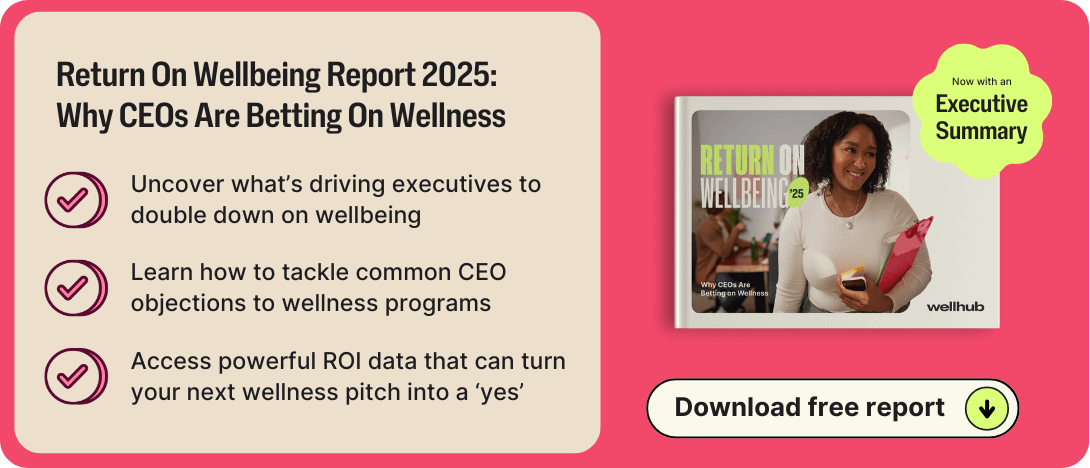
- Toxic Workplace Relationships
Team dynamics matter: Toxic workplace relationships are a leading indicator predictor of burnout. Poor relationships with colleagues or managers, combined with a negative workplace culture, can quickly turn day-to-day work into a draining experience. This is a widespread problem, with about 16% of employees saying they have "extremely unhealthy” workplace relationships.
- Inequity and Unfair Policies
Employees notice when they’re treated unfairly. Lack of equity—whether in promotions, pay, or recognition—drives frustration and disengagement. Fair, transparent policies are essential for maintaining morale and preventing burnout.
- Values Misalignment
When employees don’t feel connected to their organization’s mission or values, motivation and engagement suffer. A lack of shared purpose erodes emotional wellbeing and heightens burnout risk.
Don’t let burnout take hold of your office. Here’s how to prevent burnout in your workforce.
United States Burnout Statistics
U.S. employees are reporting historically high—and still rising—levels of burnout.
More than a quarter of the U.S. workforce is burnt out, with rates soaring in people‑facing sectors such as health care and education and among younger generations. Heavy workloads, insufficient staffing, unfair or “toxic” management practices, stagnant pay, and blurred work‑life boundaries dominate the list of causes.
The business costs are severe—burned‑out employees are up to six times more likely to quit, and credible research converges on the same prescription: systemic fixes that reduce job demands and strengthen supportive, inclusive cultures work far better than individual wellness apps alone.
Prevalence & Trajectory
- One in four employees in the U.S. (28%) say they are burnt out.
- Nearly one‑third (31 %) of U.S. workers feel “often or always” stressed by their job as of February 2025.
- Feeling burned out leaves 44% of U.S. employees “emotionally drained” and 51% “used up” at the end of each workday, symptoms directly related to withdrawal, diminished collaboration, and detachment from organizational culture.
- Emotional exhaustion affected 25 % of workers in the preceding month in APA’s 2024 Work in America study.
- Gallup’s 2024 State of the Global Workplace shows 41 % of employees worldwide feel “a lot of stress” each day, putting the U.S. among the highest‑stress economies.
Key Drivers
- Toxic workplace behaviour is the biggest single predictor of burnout: Employees in toxic climates are eight times more likely to burn out.
- Workers cite workload (47 %), pay/compensation (42 %), understaffing (37 %) and poor leadership (40 %) as the top causes of stress.
- Almost 70% of employees believe their employer is not doing enough to prevent or alleviate burnout.
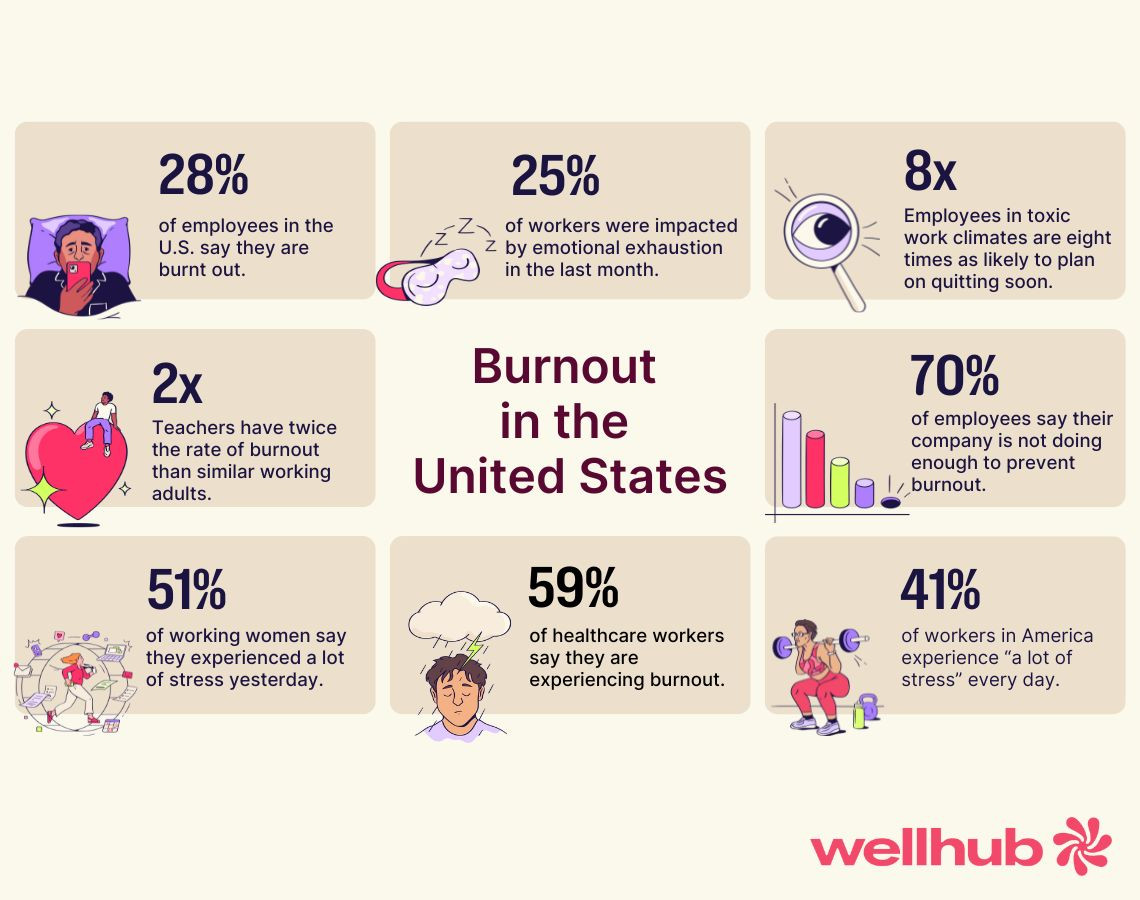
Industry & Role Hotspots
- Healthcare workers: More than half (59%) of healthcare workers are stressed by burnout, up from 32 % in 2018.
- Teachers: roughly twice the rate of frequent burnout compared with similar working adults in 2024.
- Project‑managers: More than half of project managers say they’re experiencing burnout due to overwhelming stress.
- Managers and leaders: These groups were identified as the group “hardest hit by disruptive change” and thus most at risk for burnout in late‑2023 polling of 18,000 employees.
Demographic Hotspots
- Gen Z (68%) and millennials (61 %) say they are experiencing burnout, versus 47% of Gen X and 30 % of boomers.
- Younger employees (18 to 34) are 10 percentage points more likely than those 50+ to feel stressed “often or always.”
- About half of working women feel stressed daily, compared with 40 % of men.
Managers burn out too. Here’s how to combat burnout in leadership.
Proven Solutions
- Organisational, not individual, fixes matter. McKinsey research shows systemic interventions (e.g., sustainable workloads, inclusive culture, supportive growth environments) have a lasting impact.
Remove toxic behaviour: Eliminating high‑toxicity climates would cut burnout risk by a factor of eight.
- Strengthen frontline staffing: The CDC’s 2024 Impact Wellbeing campaign provides a 6‑step guide for hospitals to rebalance workloads—early pilots reduced nurse burnout indicators within three months.
- Train people‑managers: 76 % of HR pros plan manager soft‑skills training after identifying leadership gaps as a root cause of burnout.
- Align work with employee preferences: Employees whose current work environment is their preferred work environment (whether that’s hybrid, office, or at home) are more likely to say they are good or thriving — and less likely to be struggling or really struggling — than workers.
- Invest in recognition and purpose: Employees whofeel their work “makes a positive difference” are 12 percentage points less likely to report stress.
These numbers show burnout is a workplace design problem. It’s fueled not by a lack of individual resilience, but by systemic issues like job overload, poor leadership support, and cultures that don’t prioritize inclusion or purpose.
The good news? You can take action. Organizations that rebalance workloads, staff teams properly, invest in empathetic leadership, and build inclusive, purpose-driven cultures aren’t just reducing burnout—they’re setting the standard for what work should feel like.
How HR Teams Can Support Employees Experiencing Burnout
Burnout doesn’t look the same for everyone. While some employees show clear signs of exhaustion, others might struggle more with cynicism, reduced confidence, or emotional detachment. As Dr. Michael Leiter, a leading burnout researcher, explains: each person’s burnout profile is unique, so your support strategy should be too.
Here’s how HR teams can proactively address burnout across your organization:
Focus on Recovery and Prevention
Because burnout is largely driven by workplace conditions, addressing it requires organizational change, not just individual coping strategies. Start by identifying common stressors and making adjustments at the team or company level. Simultaneously, encourage personal strategies like mindfulness breaks, stress management, and stronger peer connections to help employees recharge.
Burnout can be cured. Dive deep into how you can treat burnout here.
Train Managers in Empathetic Leadership
Poor management is a common trigger for burnout. Investing in leadership development equips your managers to guide teams with empathy, communicate clearly, and recognize early signs of burnout before they escalate.
Support Remote Employees
Burnout can be harder to detect in remote or hybrid teams. Frequent check-ins, open communication channels, and periodic in-person meetups can help managers spot disengagement and provide timely support. Tools like pulse surveys or wellbeing checklists can also help HR teams monitor remote employee wellness.
Create Clear Career Paths
Growth opportunities fuel engagement. Ensure employees have clear roles, realistic expectations, and visible paths for advancement. Transparency about job responsibilities and career trajectories can reduce frustration and help employees feel motivated rather than overwhelmed.
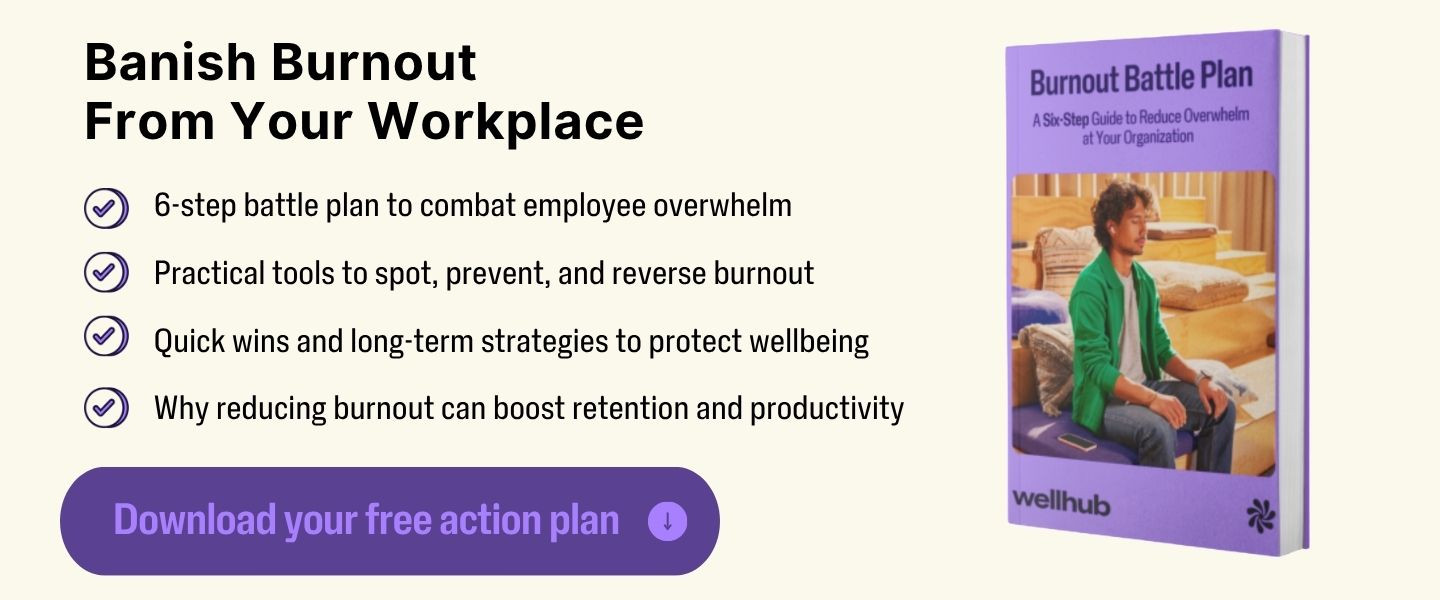
Promote Healthy Habits On and Off the Clock
Short breaks and wellness interventions—like meditation sessions, flexible breaks, and dedicated recharge time—help reduce burnout symptoms. An experiment run by the performance coaching company Exos in partnership with Hofstra University found that wellbeing support during the workday significantly increased employee engagement when coupled with dedicated recovery spaces and structured rest periods.
Encourage physical activity and self-care outside of work as well. With many employees reporting time and energy as barriers to exercise, integrated wellness benefits like Wellhub can make healthy habits more accessible.
Offer More Control and Flexibility
Chronic fatigue often stems from a lack of control over workload and schedules. Offering flexible hours, autonomy in project selection, and input into goal setting can help employees feel more empowered and less overwhelmed.
Fostering a culture of feedback—where employee insights shape policies and workflows—also builds trust and helps your people feel heard.
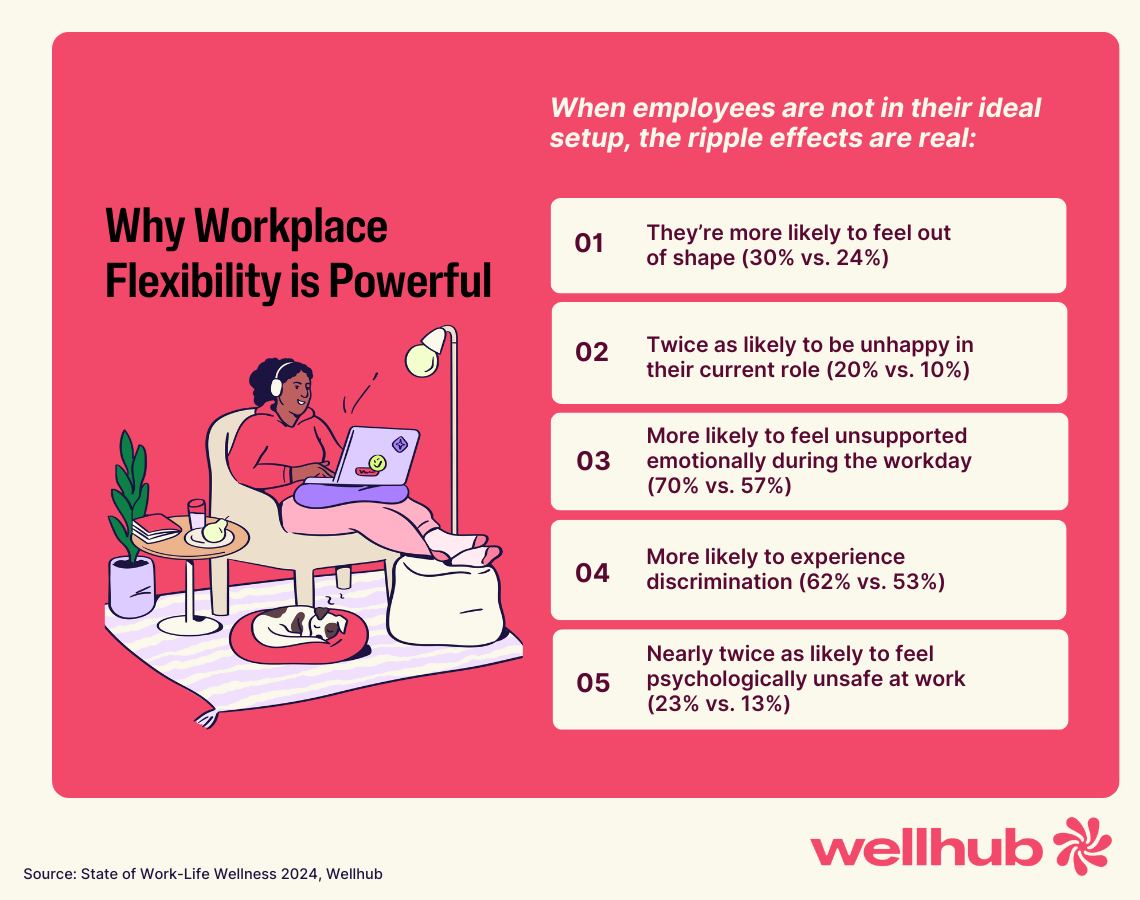
Make Employee Wellbeing a Business Priority
Burnout drains employees and hurts business results. Understanding what causes burnout helps you build a plan that supports real, lasting employee wellbeing.
The most effective programs treat wellbeing as a whole-person strategy. Physical activity, mindfulness, therapy, and nutrition all play a role in reducing stress and re-energizing your team. Adding benefits like gym access, wellness apps, and coaching gives employees the tools they need to protect their mental health.
Wellhub makes it simple to support your people. With access to thousands of activities and resources, employees can recharge in ways that fit their lives.
Ready to build a culture of wellbeing? Connect with a Wellhub specialist today and discover how we can help your workforce feel and do their best.

Company healthcare costs drop by up to 35% with Wellhub*
See how we can help you reduce your healthcare spending.
Category
Share

The Wellhub Editorial Team empowers HR leaders to support worker wellbeing. Our original research, trend analyses, and helpful how-tos provide the tools they need to improve workforce wellness in today's fast-shifting professional landscape.
Subscribe
Our weekly newsletter is your source of education and inspiration to help you create a corporate wellness program that actually matters.
Subscribe
Our weekly newsletter is your source of education and inspiration to help you create a corporate wellness program that actually matters.
You May Also Like

Corporate Wellness Trends HR Must Know for 2026 | Wellhub
See the top 2026 wellness trends shaping performance, retention, and culture—plus how HR can build a unified, ROI-driven wellbeing strategy.

Wellness Points Programs: Boost Employee Health & Engagement | Wellhub
Turn your workplace wellness strategy around with a points program that rewards healthy behavior with perks, from extra time off to gift cards.

Employee Financial Wellness Programs: Ultimate HR Guide | Wellhub
Create an effective financial wellness program that supports your employees in their financial needs, boosting productivity and retention.